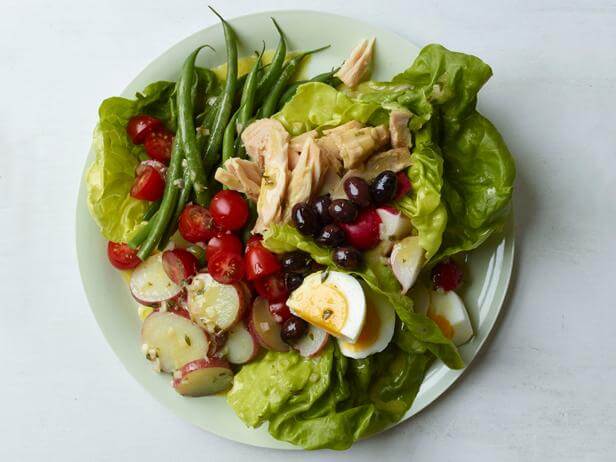Enjoy your “salad days” at the senior center
In medieval times salads were composed of green leaves, sometimes with flowers. Le CouCou in New York City picks up on this theme, adding crab. Their fleurs de courgettes farcies au crabe will set you back $32. The menu doesn’t indicate what accompanies the lobster in salade de homard, but let’s hope it’s good because it costs $52.
As the story goes, Caesar salad was invented on July 4, 1924, by Italian immigrant Caesar Cardini. After his restaurant in Tijuana ran out of ingredients, he combined leftover romaine lettuce, olive oil, egg, garlic, Parmesan and Worcestershire sauce, which he tossed at the table.
Sorellina in Boston seems to be one of the few fine dining restaurants with a traditional Caesar salad on the menu — for $21.

Chama Gaucha in Houston offers a Caesar salad dinner. Their salad includes red onions and strawberries and diners choose a meat to accompany it — for $52.
In Denver, Chez Maggy doesn’t have Caesar salad on the menu, but they offer Tuscan kale salad with peanuts for $16 or chopped salad with chickpeas, olives, mushrooms and chicories with mustard-sesame dressing for $15.
The Fog Harbor Fish House in San Francisco will serve you crab and avocado Caesar for $31. But if you ask for Caesar dressed leaves of romaine, it’s yours for $12.
Anyone who reads the Sunday New York Times Magazine knows that “Judge” John Hodgman is a man of strong opinions. When Jillian from Quebec wrote in, mentioning a disagreement over the fact she puts cauliflower in Caesar salad, Hodgman declared: “The Caesar is a documented, modern salad, invented in the 1920s. Most salads are free-form bowls of whatever junk you have rotting in your crisper, but the Caesar was from its beginning defined as much by its ingredients — romaine, garlic, egg yolk, Worcestershire, Parmesan, croutons — as by its elaborate tableside preparation. This was salad as theater. And while I can’t prohibit you from insulting that tradition with cauliflower, take credit for your innovation and call it what it is: Jillian’s Quebecois non-Caesar.”
We can only wonder what Hodgman would say about the full-color picture of a Caesar salad topped with batter-fried anchovies in another issue. Or the many other iterations they’ve offered in more than 2,000 entries for this salad. In the pages of all the news that’s fit to print, various Caesar salads include mussels, avocados, black beans, beets, caviar and lots more.
According “The Escoffier Cook Book,” to make Parisienne potato salad you need to add two-thirds pint of white wine per 2 pounds of potatoes, and then season with oil, vinegar and add some chopped chervil. Julia Child advises 4 tablespoons of white wine or 2 tablespoons of white vermouth.
Wikipedia offers a fascinating read on Russian potato salad. A recipe appearing in 1894 called for half a hazel grouse, 2 potatoes, a small cucumber (or a large cornichon), 3-4 lettuce leaves, 3 large crayfish tails, 1/4 cup cubed aspic, 1 teaspoon of capers, 3-5 olives and Provençal dressing.
I have two German cookbooks in my kitchen and thus two versions of potato salad. The Armenian cookbook sent to me when my college history professor found out I’d married an Armenian has a third version. George Bernard Shaw’s “Vegetarian Cooking” recommends adding one cup of mayonnaise to 4 boiled potatoes and 2 celery stalks. Even ”The Dreaded Broccoli Cookbook” has a recipe for potato salad. I think I only own two cookbooks without potato salad recipes.
My mother’s tasty potato salad was applauded at church and Grange suppers. When I called her for advice about the tastelessness of mine, she advised, “Use only the egg yolks. Dump the tasteless whites.” As a child of a post-Depression household where the dogma was: “We don’t waste food,” this culinary advice shocked me to the core.
The 2,210 entries for potato salad in The New York Times are about adding, not eliminating. There, Japanese potato salad needs mashed potatoes, ham, hard-boiled eggs, carrots and corn. Another recipe includes mentaiko, salted sacks of pollock or cod roe — “highly appreciated, difficult to find and thus very expensive.”
Other recipes call for turmeric, chives, pesto, cinnamon, mint, caviar, horseradish, tahini, jalapenos, avocados, cannellini beans, capers, anchovies, okra, purslane leaves, snap peas, sun dried tomatoes, kimchi, pine nuts, cashews, caviar, herring, mussels, octopus, lamb, smoked salmon, duck, ham, bacon, tongue. And more.
There is a January 1938 story about a Connecticut man who won a divorce settlement because his wife fed him so much potato salad that he developed stomach ulcers.
No matter what ingredients are in the Caesar and potato salads at Monday Munch, they will appear in the Charlotte Senior Center tradition of conviviality, getting together for good food and conversation.
Monday Munch
Sept. 25, 11:30 a.m.-12:30 p.m.
Chili, Caesar salad, corn bread, apple pie and ice cream.
Octoberfest Monday Munch
Oct. 2, 11:30 a.m.-12:30 p.m.
Bratwurst on roll with grainy mustard and sauerkraut, German potato salad, root beer and surprise dessert.
